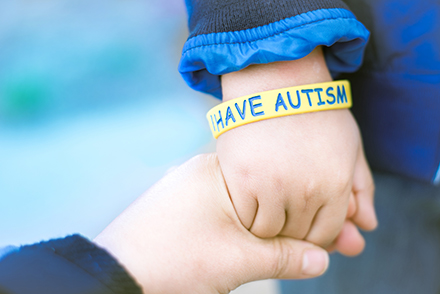Julie Leibach

For more than two decades, NIEHS has explored environmental contributions to autism, supporting collaborations in the U.S. and abroad through a dedicated extramural funding program.
Initial research support coincided with growing public interest in autism, also known as autism spectrum disorder. The term describes a broad range of complex conditions that affect communication and behavior. Symptoms include difficulties with social interaction, as well as restricted and repetitive behaviors and interests , such as body rocking or preoccupation with particular objects or topics. Many people with autism also have other medical conditions, such as epilepsy, sleep and mood disorders, and gastrointestinal problems.
"There's a lot of variation in how autism is expressed among individuals that have a diagnosis," said Cindy Lawler, Ph.D., chief of the NIEHS Genes, Environment, and Health Branch. "Autism is generally a lifelong condition, and each autistic individual has a unique set of strengths and challenges that unfold over the life course."
Building a Legacy
In 2000, former President Bill Clinton signed into law the Children's Health Act , designed to expand research on various diseases and conditions that especially affect children. The act authorized NIH and the Centers for Disease Control and Prevention (CDC) to prioritize research on autism, including studies on causes, early detection, and treatment.
The legislation dovetailed with an initiative already underway at NIEHS to better understand how environmental exposures interact with genes to cause disease and other medical conditions. As part of that initiative, former NIEHS director Kenneth Olden, Ph.D., embraced research on autism, which was growing in prevalence in the U.S.
"Ken Olden was really interested in exploring whether there was something in the environment that might be driving increases in autism rates," Lawler said.
Under Olden's leadership, NIEHS joined the Interagency Autism Coordinating Committee (IACC), established by the Children's Health Act to advise the Secretary of Health and Human Services on autism research and other activities, and began building an autism program. The first projects received funding in 2002.
"When it comes to funding studies on the environment and autism, especially chemical contributors, NIEHS is at the forefront," said Astrid Haugen, a health specialist who leads NIEHS activities to raise public awareness and promote collaboration among autism researchers.
Conducting Groundbreaking Research
Autism is highly heritable, meaning that it can be passed down through genes and molecular modifications to genes. However, research shows that nongenetic factors such as parental age and preterm birth are risk contributors. In addition, growing evidence suggests that environmental contributions, such as dietary nutrition or exposures to chemical contaminants, also play a role.
Globally, an estimated 1 in 100 children has an autism diagnosis, according to a 2022 review , although other studies have indicated much higher rates. Meanwhile, autism prevalence in many low- and middle-income countries is unknown, the World Health Organization noted .
Promoting Early Detection

A reliable autism diagnosis is usually available by age 2, when symptoms become obvious. Because the first years of life are a crucial period for language development and other social communication, identifying autism earlier could lead to helpful therapeutic interventions, research suggests .
To that end, NIEHS supports studies on biological indicators, or biomarkers, that can predict autism. For instance, a team led by Manish Arora, Ph.D., of the Icahn School of Medicine at Mount Sinai, studied deciduous teeth - baby teeth that kids lose - for signs of exposures to essential and toxic elements. Fetal and early-childhood exposure to toxic metals and deficiencies in nutritional elements have been linked to several developmental outcomes frequently associated with autism, the researchers noted.
Building on their earlier work, Arora's team has developed a diagnostic test for children younger than 18 months old that relies on hair samples. Using an imaging technique, the test scans a strand of hair for patterns associated with metabolism of essential and toxic elements. An algorithm then calculates the likelihood of an autism diagnosis based on detected patterns. Reporting in 2022, the researchers found they could predict the emergence of autism as early as 1 month of age with over 81% accuracy.
In 2021, the U.S. Food and Drug Administration recognized the test as a " breakthrough device ," a designation intended to speed up the development of certain medical technologies that could significantly benefit public health.
"The prospect of earlier autism detection means that families can begin receiving support for their children during a critical time in neurodevelopment," Lawler said.
Since 2000, autism rates in the United States have increased more than 400%, according to the CDC's Autism and Development Disabilities Monitoring Network . Today, approximately one in 36 kids in the U.S. receives an autism diagnosis by age 8.
"Parsing the reasons for the increase is difficult, in part because of changes in how autism is diagnosed and an increased awareness and availability of services," Lawler said. "Those factors can obscure the impact of any changes in environmental exposure patterns."
To explore associations between autism and the environment, NIEHS has funded several pioneering longitudinal health studies, which have observed the same group of people over a period of time. The earliest, launched in 2003, is CHARGE , for Childhood Autism Risks from Genetics and the Environment. Based at the University of California, Davis (UC Davis), the study has enrolled more than 2,000 children.
"CHARGE is the first domestic large-scale, population-based, case-control study of risk factors for autism," said Lawler, referring to a type of study that compares people who have a particular condition with a similar group that does not. "The project has been incredibly productive and has uncovered some really important findings."
For example, a team led by Heather Volk, Ph.D., of Johns Hopkins University, used CHARGE data to examine connections between air pollution exposure and autism. Reporting in 2014, her team found that mothers who had a version of a gene, or genetic variant, associated with autism and who were also exposed to higher levels of traffic-related air pollution while pregnant had a greater chance of having a child with autism compared to women with the genetic variant but who had encountered lower levels of air pollution.
"The finding suggests a gene-environment interaction that contributes to autism risk, and it is likely that many other interactions are at play," Lawler said. "In other words, looking only at a person's genetics may not tell the whole story. In some cases, an exposure or exposures act together with genetic background to influence the outcome."
Data from CHARGE has revealed other signs of gene-environment associations as well. In 2012, a team led by Rebecca Schmidt, Ph.D., of UC Davis, found that mothers who took higher amounts of supplemental folic acid in the first month of pregnancy were less likely to have a child later diagnosed with autism than women who consumed less of the vitamin - but only if they also had a genetic variant associated with inefficient folate metabolism and function.
Following that work, Schmidt and colleagues explored links between folic acid supplementation and pesticide exposure, which has been implicated in autism. They found a reduced association between autism and gestational pesticide exposure among children born to women with higher folic acid intake in the first month of pregnancy compared to children of women with lower intake.
Thanks to recent funding from the NIH Autism Centers of Excellence program, the quest for gene-environment interactions is poised for more leaps. A new center at Johns Hopkins will combine 18 existing autism studies - comprising about 175,000 participants - to create a richer data set for mining. Led by Volk and Chris Ladd-Acosta, Ph.D., the center is called GEARs, an acronym for the Combining advances in Genomics and Environmental science to accelerate Actionable Research and practice in the ASD Network .
For Lawler, the center represents the future of autism research.
"If we're going to get serious and provide strong evidence for gene-environment interactions, different research groups need to join forces," she said. "It's all coming together just at the right time."
Welcoming Outside Insight

The NIEHS autism program invites research perspectives beyond its grantee portfolio. For example, Lawler invited Mark Shen, Ph.D., of the University of North Carolina at Chapel Hill, to share highlights from his work during Autism Awareness Month this past April. Shen integrates neuroimaging, genetics, and clinical assessment in young children to study the early onset of neurodevelopmental disorders.
In one study, Shen and colleagues used MRI to examine a part of the brain called the amygdala, which is larger than average in toddlers with autism. The team found that rapid amygdala growth begins between 6 and 12 months of age , before social difficulties appear, suggesting an opportunity for early diagnosis.
"We were particularly interested in Dr. Shen's translational perspective," Lawler said. "His research reflects that back and forth - from neuroimaging in infants and children to mechanistic studies in animal and cell models, as well as clinical trials - that is needed to ultimately bring discoveries forward to improve the lives of individuals with neurodevelopmental disorders."
The NIEHS autism program's collaborative philosophy extends beyond U.S. borders. In May, Lawler and Haugen convened in Sweden for a meeting with fellow members of the Environmental Epidemiology of Autism Research Network, or EEARN, a partnership with the nonprofit Autism Speaks. The network provides a forum for idea-sharing while also supporting early investigators.
"This year's event included broad discussion of the needs of early-career researchers," Lawler said.
"There are many challenges for junior investigators trying to enter the field of autism and environment research," Haugen added. "It was heartening to see these up-and-coming researchers present and receive advice from our senior investigators."


